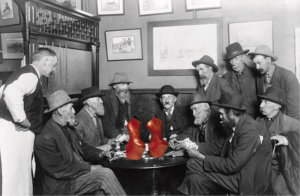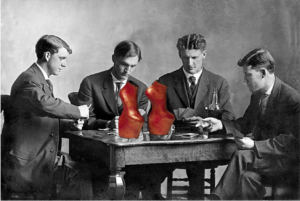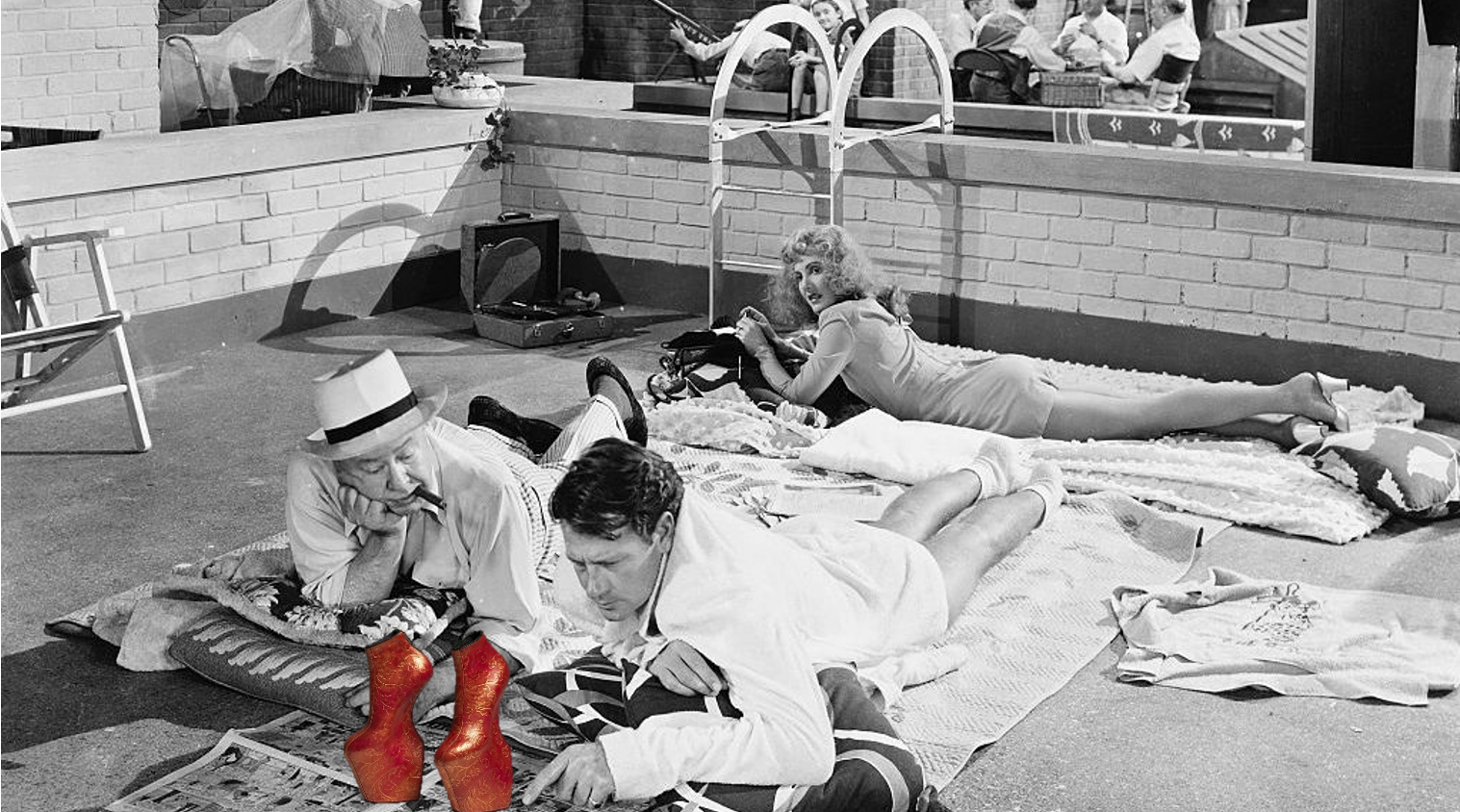The Red Shoes: Frameworks that Form Our Identity
by Elisabeth Rulke
“What desires did objects organize? What fantasies did they provoke? Through what economies were they assigned new value? Through what epistemologies were they assigned meaning? Today, how do we ask material objects to represent us, to comfort and help us, to change us? Today, do we collect things in order to keep the past proximate, to incorporate the past into our daily lives, or in order to make the past distant, to objectify it (as an idea in a thing) in the effort to arrest its spectral power? Do you grant agency to inanimate objects because you want to unburden yourself of responsibility? Or because you need to mark how overwhelmed you are by your material environment? Or is it simply because you’re lonely? Because, unlike a child, you don’t have a toy to talk with?”
– Bill Brown, A Sense of Things
The red shoes portrayed in the pictures are titled “Lady Bloom” by Japanese artist Noritaka Tatehana. His handcrafted footwear is inspired by traditional Japanese (taka)getas, elevated flat wooden sandals, particularly the high, lacquered versions worn by elite courtesans, or Oiran[1]. As Tatehana states, “Only Oiran were allowed to wear the extremely high-heeled clogs, takageta, as their status symbol. Everyone knows this high heel is torture to wear, but they regarded Oiran who wore these platform clogs with awe.”[2]
Like their historical precedents, Tatehana’s shoes alter the wearer’s manner of walking, precariously shifting one’s balance forward[3]. The effect of the shift in the center of weight of the individual limits their ability to stabilize their own walk, preventing them from moving around independently and often requiring assistance to walk properly. However, elevated footwear has long been seen as valuable enough to wear despite their lack of utility as ‘shoes’ purposed to protect and cover the feet in addition to active discomfort that they instigated. The idea of being ‘elevated’ was reserved for the elite, and yet it actively took power away from the woman who wore it by creating the need to physically lean on and be supported by patrons[4].


All the images are set in black and white, creating significant juxtaposition with the bright cardinal red of the heels. This deliberately brings attention to the shoes as the focal point of the gaze of not only the individuals in the pictures, but also the gaze of the viewer observing the image. Despite the dimensional barriers that separate the physical viewer from the audience in the pictures, the focus and gaze of both parties is centered on the shoes and what ideas it holds not only as an object but as a broader concept of the scrutiny and surveillance that beauty regimens implement on the wearer. The watchful gaze probed by these images begins to define the search of finding the meaning of these shoes and perhaps more importantly, meaning for who?
The exhibition image consists of two men lying down, backs turned to a female who is lying behind them, gazing in apprehension as they observe the red shoes. She herself is wearing heels and a dress that exposes most of her legs, however this goes unnoticed by the men who are more interested in the fetishized idea contained by the object than the woman herself. It is this concept of value creation through the lens of the male gaze that has been subconsciously enforced on all genders, to the extent to which they use these societal structures to reward themselves and self-inflict the pains of “beauty” that inspired the alterations of the image of the “Lady Bloom” shoes to settings surrounded by men. I specifically used white men, who have historically dominated the formation of the patriarchal frameworks from which modern beauty standards arose.
Fashion is not useful – these shoes are impractical for the sense of walking or protecting one’s feet. This brings us to the question of the commodity value of something that is not useful and why we still choose to buy and possess such items. Bill Brown argues that commodity fetishism appears when the value and power of material objects are divorced from the human power and social interaction that brought those objects into being[5]. This affects fashion by driving the social frameworks that award objects like high heels a status of power and value. The shoes allow women to gain value in a society that is built and structured around the desires of man. These images inspire deeper thinking about what desires, fantasies and meaning that objects women consume contain within them.
This then begs the question: why do we even wear these things, why do we even subscribe to any beauty standards, wear makeup, tight clothes, do anything that is uncomfortable if we ourselves don’t directly gain value from it? Because we do gain value from it, but indirectly. By being elevated in the eyes of others, more specifically by producing a sexual pleasure in the eyes of men and thereby being awarded the title of ‘sexy’. Take the image of Marylin Monroe in the red shoes for example. She is gaining pleasure from the value that she is awarded due to exciting the sexually explicit gaze of the man that is watching her. Perhaps she is also enjoying the feeling of the breeze lifting her dress or the way the fabric of the dress feels against her skin, but these pleasures are indefinitely coupled to the reaction that she receives from those around her such that you cannot separate the value gain from one without the other.

Kaja Silverman introduces the concept that we need others to help us define who we are: we use the eyes of others as a ‘mirror’ to see our own bodies and lives such that the outside gaze develops our own sense of self[6]. The framework of the meanings created by the gaze of ‘others’ forms an identity coupled to the object which they are observing that seeps into the value gain that us women who consume/possess these objects seek to achieve. We don’t wear these objects to gain intrinsic value but to gain external societal value (which is sometimes well disguised as intrinsic value), because at the end of the day we cannot identify ourselves without the gaze of others in the same way that we cannot value ourselves while existing in society without being somewhat valued by the society we inhabit.
Silverman notes that each part of the female body has can be individually packaged and sold as a ‘fetish’ or a ‘desire’ due to what she labels the “Free-floating quality of female sexuality” in which each individual part of the body creates an erotic admiration whereas in men this same sentiment is concentrated only on the genital area[6]. I wanted to explore this idea and how the idea of shoes encapsulates this unique and distinct quality of female sexuality by placing only the shoes, with no feet in the center of the images surrounded by men. The use of black and white merges the form of the figures of men, actively combating the “free floating quality” that the red shoes represent and thereby intensifying the gaze that focuses on the heels.
Joan Didion synthesizes that once you know who you are, then you can have self-respect, own up to your own actions and be able to live a life for yourself[7]. Through the images I attempt to highlight that, in order to see yourself and develop self-respect in a world with other people whose gaze is ever present in our own personal identities, you might not always be really respecting yourself but idea of the identity you have created through the labyrinth of a male centric framework.
Cosmetic surgeries, high heeled shoes and even certain clothes are used despite being uncomfortable because we seek to gain value in structures that are catered towards men, but they are the only ways in which we can gain widely recognized value in our society. The way that we see ourselves comes through knowing how we are viewed by the people that surround us and traverse life with us. Knowing that we are a product of our environment, these altered images seek to understand in what ways we see ourselves and assign value to ourselves. Through our materialistic consumption we fulfill the biological instinct to seek rewards in our societies. Our identities are portrayed by the objects that we use to cover our bareness as individuals and to characterize our own essence, but these characteristics and our own selves all have (sometimes unknowingly) imprints of the patriarchal frameworks that have dominated human history.
References:
[1] Metmuseum.org, https://www.metmuseum.org/art/collection/search/172904.
[2] Hasegawa, Kanae. “Noritaka Tatehana: Refashioning Beauty.” Studio International: Visual Arts, Design and Architecture, https://www.studiointernational.com/index.php/noritaka-tatehana-refashioning-beauty-review-portland-japanese-garden-united-states.
[3] Metmuseum.org, https://www.metmuseum.org/art/collection/search/172904.
[4] Hasegawa, Kanae. “Noritaka Tatehana: Refashioning Beauty.” Studio International: Visual Arts, Design and Architecture, https://www.studiointernational.com/index.php/noritaka-tatehana-refashioning-beauty-review-portland-japanese-garden-united-states.
[5] Brown, Bill. “A sense of things: the object matter of American literature.” University of Chicago Press, 2003, pp 8.
[6] Silverman, Kaja. “Fragments of a fashionable discourse.” Studies in entertainment: critical approaches to mass culture. Indiana University, 1986.
[7] Didion, Joan. “On self-respect.” Vogue Magazine (1961).
Image from Met Costume Institute, https://www.metmuseum.org/art/collection/search/172904. Artist: Noritaka Tatehana.

